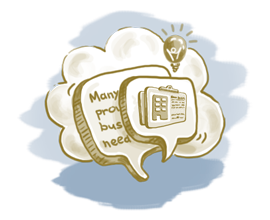The call to action is the most important element of any lead generation activity.
It is the part of your email, web page, landing page or other device that causes the reader to act (hence the name). That is, click through to a software download, fill out a contact form for more information, “call us right away,” download trialware, or the like. It is even used in verbal presentations; at the end of a webinar or video presentation the presenter says something like, “Call us today to find out how you can take advantage!”
Some businesses miss out on the necessity of creating and including calls to action in everything they do. You might do a splendid job of selling someone on the idea of finding more or even making a purchase—but if you don’t give them an instant way to do that, it could be a sales opportunity lost.
The call to action is placed at the end of a pitch—such as at the end of an email or on a web page that should result in interest turning to a lead. Many experts, however, advise the placing of a call to action on every single web page in a site as you never know when someone will decide they are interested; it may be earlier than you expect.
There are other scenarios in which a website might contain different pages that address different levels of interest; in such a case different calls to action for each page might be required.
 Inciting Action
Inciting Action
How do you know what will cause your potential customers to act? That is a matter of research. You need to know your customers well enough to know what made them act in the first place. Then conduct research on new people that have not purchased, and find out what would cause them to want to move to the next stage in your sales process.
Too many companies make calls to action a matter of guesswork; they make assumptions about what will cause a prospect to act, put up calls to action and hope for the best. That’s a far more expensive way to go than getting the research done in the first place.
Creating a Call to Action
When you’re first creating a website—especially when you’re first starting out and have no budget—a text-only link might be all you can afford. If so, do that; something is always better than nothing. If you base that call to action on your research, it should still work.
But most lead generation experts will point out that a call to action should stand out from the rest of your design and attract attention from the moment a viewer first lands on a web page. That way the reader always knows it’s there; the moment he or she is pushed over the edge into becoming a lead the action is only a click away.
There are many experts out there who can design a call to action for you, one that will fit in with your design and color scheme yet nicely stand out. They have tested various designs and colors as to response—it’s worth tapping this expertise to gain the most possible traffic.
Simplicity of Verbiage
A call to action should be simple yet effective. It should have a minimum of carefully chosen words; the less cluttered the better. It should clearly and rapidly communicate exactly what you want the reader to do.
You want to firmly direct your public, and keep them moving. If you want someone to download a white paper on cloud solutions, for example, don’t go crazy with something like, “Download our free white paper about cloud computing in today’s environment and why our solution will make a huge difference in your computing ROI.” A simple, “Download our cloud solutions white paper!” will do much better.
Again, there are experts that can show you many examples of the types of wording that have been the most successful.
Testing and CRM Solution
Once you have designed one or several possible calls to action, you can actually show them to either customers or potential prospects and get their input on what will cause them to act. When you have made your calls to action live, though (whether or not you have shown them around beforehand), you should employ web analytics that will reveal how many of your visitors click on various calls to action. Keep careful track of them, testing various ones to see which work best.
Of course, the final analysis will be monitoring the resultant leads through a leading-edge CRM solution; Who bought? Who didn’t? Which leads from which calls to action turned to sales the fastest?
Calls to action are vital to your lead generation. Give them the attention they deserve—and so will your prospects.
What kind of CRM solution allows you the best tracking of leads through your sales process? Find out! Get your free trial of Pipeliner CRM now.










